Hello again and welcome back to my blog.
My week was a little less full than I had expected. You see, December is turning out to be a very snowy month this year. In fact, it has been — to date — the second snowiest December in history here in Boston. Because of that, some events planned for last Sunday had to be canceled.
Nevertheless, the advent season is rapidly leading us into Christmas.
In Luke’s Gospel the evangelist shares with us that one starry night on a hillside outside of Bethlehem choirs of angels proclaimed the Good News of the savior’s birth to shepherds tending their flocks. After proceeding in haste to find Mary, Joseph and the infant Jesus, the shepherds shared their discovery with the people of the surrounding area and went forth giving praise and glory to God. The belief of the shepherds and of the people who heard their witness set in motion a sharing of faith that has endured for over two millennia and has spread to all corners of the world.

Following the example of those present for the first Christmas, we must share our faith with our families, friends and communities. The world needs us to proclaim the truth that our savior Jesus Christ was born of the Virgin Mary, the truth that God is with us. Increasingly the darkness of oppression, persecution and lack of respect for human dignity threatens us. In too many ways the truth that each and every person is created in the image and likeness of God is denied. We must work together to help each other to live the call to holiness and realize our potential as members of God’s family. We must let the light of Christ that is present in each one of us shine forth. In doing so we give the greatest and most enduring gift, the love of God.
Please be assured of my prayers and remembrance during the Christmas season and throughout the year.
– – –
We receive the news of Professor Mary Ann Glendon having been confirmed as the United States ambassador to the Holy See with great joy. Dr. Glendon will be an extraordinary representative of the United States and her service will be a particular source of pride in the Archdiocese of Boston, as she is a member of our local church. We are grateful to the U.S. Senate for the expeditious handling of the confirmation hearings and the unanimous vote for Dr. Glendon’s appointment.
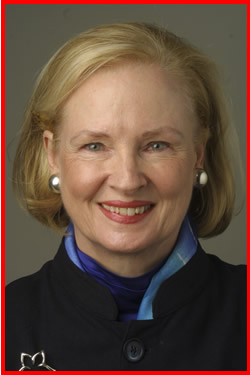
The United States’ Ambassador to the Vatican assumes very significant responsibilities on behalf of our country and the Church. Dr. Glendon’s achievements in the legal, academic and religious communities provide an outstanding resource to fulfill this important role.
A highly respected and legal scholar with a distinguished teaching and research career, Dr. Glendon is magnificently prepared for this assignment. She has been an articulate and engaged Catholic intellectual with a background in both Catholic and university settings (most notably with her present appointment at Harvard) and has published extensively on Catholic social teaching. Having previously served as head of the Pontifical Academy of Social Sciences and the Holy Father’s representative to the United Nations 1995 Beijing Conference on Women, Dr. Glendon is well established as an international leader on behalf of the Church. We assure her of our prayers and pledge our support for her ambassadorship.
– – –
After over two years of waiting since the terrible fire that destroyed their church, the parishioners of Sacred Heart Parish in Weymouth gathered for the very beautiful celebration of the dedication of their new church building.
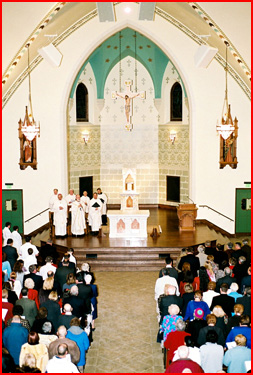
The seven-alarm fire completely destroyed the original building in June 2005, and only a few items were saved.
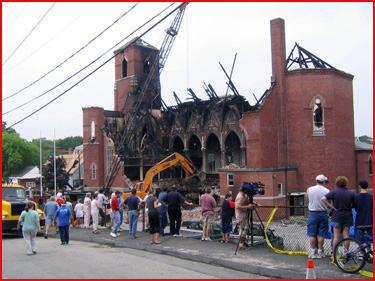
Firefighters were able to go in and bring out the tabernacle, which is now in the new church building. The wooden cross from the original steeple survived the flames and was found in the ruble. It is now in the new church’s parish center.
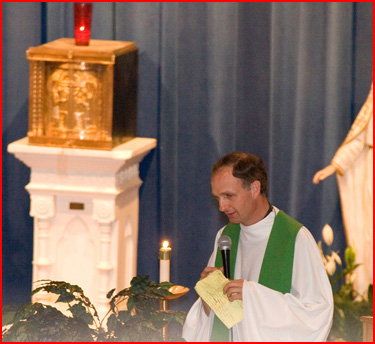
In this photo taken in 2005, you can see Father Dan Riley and the saved tabernacle
The original church was designed by Patrick C. Keely and was a very beautiful structure, with a very traditional look. Keely, an Irish born architect who came to America at age 25, was commissioned to build over 600 churches throughout the country, including 20 cathedrals in cities such as Chicago, Cleveland, Buffalo, Hartford, Newark, Providence, and, of course, the Cathedral of the Holy Cross in Boston.
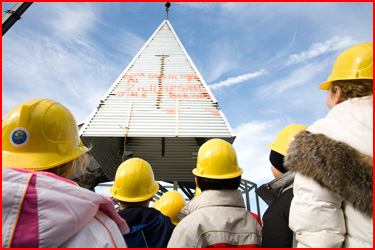
The steeple of the new church was placed back in January of this year
One of the parish’s goals was to recreate a church that would capture many of the architectural features of the original church, and that certainly was accomplished. When you drive through Weymouth and you see the new church, it looks as though it has always been there. All the stained glass windows, beautiful statues, altar and other furnishings continue the traditional feel.
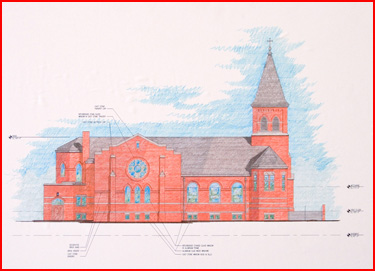
The stained-glass windows actually came from other churches in the archdiocese, including Blessed Sacrament in Jamaica Plain, St. Joseph’s in Lowell, St. Peter’s in Lowell, St. Joseph’s in Gloucester and Sacred Heart in Lawrence. The light fixtures in the main church, which have symbols of the Sacred Heart on them, are also from Sacred Heart. The Stations of the Cross are from St. Augustine’s in South Boston; the altar relics are from Holy Trinity German Church in the South End.
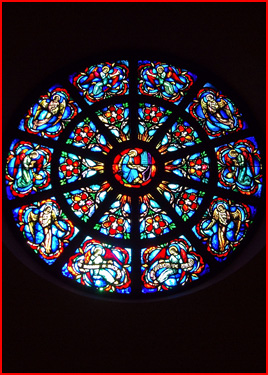
This rose window was originally placed at
the former Blessed Sacrament Church in Jamaica Plain
Now Sacred Heart has a church with a traditional air but also some modern amenities such as a sprinkler system, a parish hall downstairs, an elevator, an air conditioning system and so many features which of course not present in their original church. The pastor, Father Dan Riley, and the assistant, Father Harry Kaufman, have worked very hard with their parish council building committee. They did a wonderful job of planning and executing those plans.
Before the Mass of Dedication began, the parish gave me the keys and the building plans as a symbol of handing over their new church to the archdiocese.
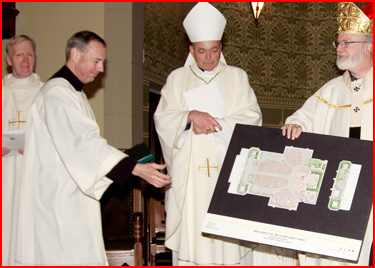
The ceremony was very beautiful. Most Catholics never have the opportunity to experience the dedication of a church, and I believe that both the ordination of a priest and the dedication of a church are two of the most beautiful liturgical celebrations that we have in the Catholic Church. At the beginning of the celebration, the church is sprinkled with holy water, the altar is anointed with sacred chrism, as are the walls, the church is incensed and there are beautiful prayers that are very, very scriptural and draw heavily from the history of salvation.
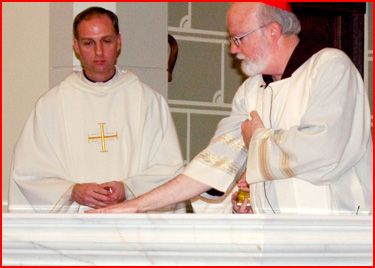
Anointing the altar
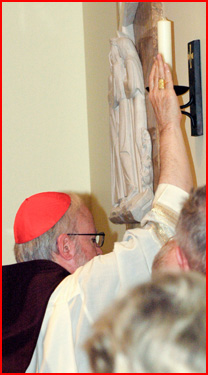
I anointed candles in the four corners of the new church
Many, many parishioners were there, and they truly seemed to enjoy the celebration. I want share with you my homily at the Mass of Dedication:
The first lesson from today’s Mass speaks to us about Nehemiah, the man who rebuilt the walls of Jerusalem and together with Ezra reestablished the temple after the period of exile. Today’s reading describes how these two great leaders assembled God’s people for the reading of the law. The people wept with emotion.
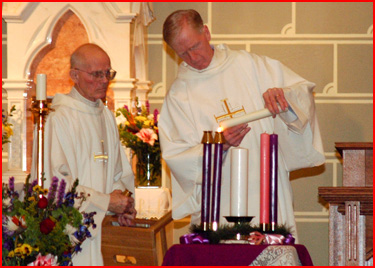
We too gather with great emotion to dedicate this Church after the disruptive exile occasioned by the devastating fire.
We are so thankful to Father Dan Riley, Father Harry Kaufman, Deacon Ken Ryan and Deacon Hank Welch, the Parish Council and leadership for all of the hard work that has resulted in this magnificent temple.
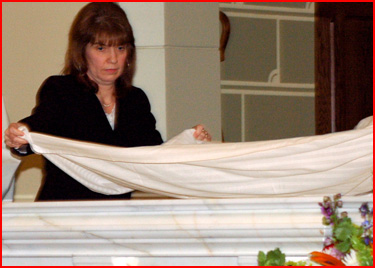
The Gospel of Zacchaeus is often used for the blessing or the anniversary of a Church. It is wonderful story of a man who, from an economic point of view, is a great success. Not only is he a tax collector, he is the chief tax collector, the head of the IRS. The tax collectors were very rich, but they were hated. They worked for the Roman government collecting taxes and exploiting the poor. Zacchaeus was physically small, socially insignificant, rejected by his countrymen as a traitor. He was rich but isolated, alone, unsatisfied with riches and power. He had heard about Jesus and wanted to see him.
Jesus was passing through Jericho on His way to Jerusalem — it was Zacchaeus’ chance. He was vertically challenged and the crowd prevented Zacchaeus from seeing Jesus. He ran ahead and climbed up the sycamore, a tree, to see Jesus.
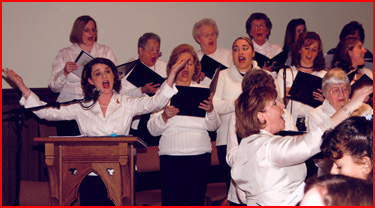
The grace in Zacchaeus’ life came in his desire to see Jesus. There were obstacles. Sometimes people are the obstacles. Zacchaeus climbed a tree showing lack of dignity. What could look sillier than an old man climbing a tree like a child? “If you do not become like little children…”
The crowd passes beneath the tree, and Jesus calls him by name, Zacchaeus, “come down quickly, I must stay at your house.” Zacchaeus almost fell out of the tree. The Gospel describes Zacchaeus’ conversion. He gave money to the poor, and makes restitution to those he defrauded — His love of God immediately blossoms in love of neighbor. His change came because he realized that Jesus loves him. Then Zacchaeus wants to change his life to be worthy of that love. The crowd sees him with human eyes with all his defects and sins, but Jesus sees what Zacchaeus can become — a new creation, a disciple, a son of God.
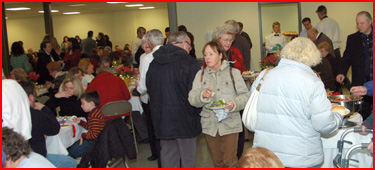
We had a nice gathering after the Mass
As a Church we are called to be a community, a family — not a crowd which pushes people away from Jesus. The crowd in today’s Gospel kept Zacchaeus from seeing Jesus. When we realize how much Jesus loves us — we are anxious to be changed, converted, to do penance for our sins. Zacchaeus gives his fortune away. Jesus did not even ask for this. It was spontaneous.
This is a contrast with the rich young man who lived a virtuous life and could not give up his wealth. He went away sad. Zacchaeus is filled with joy as he gives his fortune away. Zacchaeus is free because he knows how much he is loved.
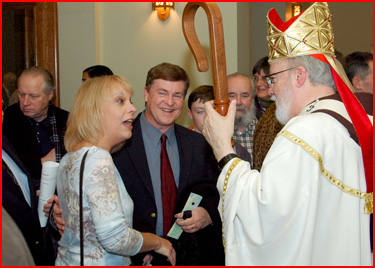
Being a parish is about turning a crowd into a community, reaching out to Zacchaeus, not pushing him away, helping people to know that they are loved by God so that they will experience that joy and be transformed. A parish is a place where we can be forgiven, loved and fed because of the life of Christ. The people in the crowd did not want Jesus to go to Zacchaeus’ house. But Jesus is telling us that going to the house of a sinner is his mission. “The Son of Man came to seek what was lost.”
Now the same mission is ours — to seek out the Zacchaeuses and tell them that Jesus loves them too.
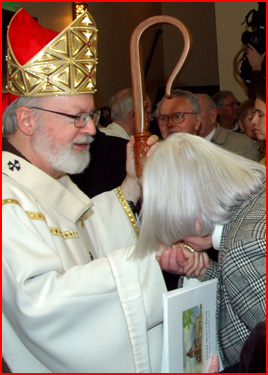
Zacchaeus is not the only tax collector who follows Jesus. The famous tax collector is Levi who heard the words “Follow me” — He followed and became St. Matthew, the writer of the first Gospel.
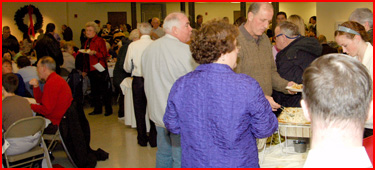
Jesus is calling all of us to discipleship, to community, to embrace a mission to experience the joy of Zacchaeus who hears Jesus’ words, “Zacchaeus, come down quickly for I must stay at your house today.” Jesus wants to dwell in our hearts and teach us how to love, to live the Great Commandment and the New Commandment.
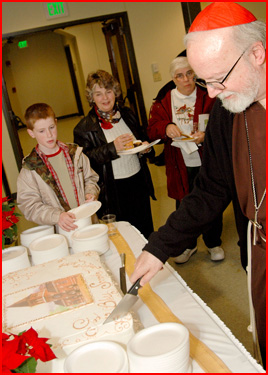
We are like Zacchaeus, overwhelmed by Jesus’ love. Despite all our faults, he wants to be our guest. That crowd of strangers becomes a community, a family when we gather around the altar that we are about to dedicate. In the Bible, there are over 450 references, mentions of altars. It is not just a piece of furniture.
The altar is the table where we gather as the extended family with Christ, the head of our family. The altar is also the place of sacrifice where Christ makes a gift of Himself.
The first generations of Catholics celebrated the Mass in the catacombs on the tombs of the martyrs. For that reason we have a tradition of putting relics of saints in the altar so that we can be inspired by the faith and example of the saints who have gone before us.
The Old Testament describes how Judas, Macabees and his men rebelled against the conquerors of God’s people and immediately rededicated the altar. Each year the anniversary of the rededication was to be observed by the people of Israel as a festival of light day and has continued as the celebration of Hanukkah. Today is our Hanukkah, our rededication of the altar.
At the Last Supper the Apostles gathered with Jesus around the dinner table that became an altar for the first Eucharist. Even as Jesus was saying farewell, He was assuring us of His abiding presence. At the Last Supper Jesus gives us a command and a gift. The command is called the new commandment, “Love one another as I love you.” This command came as part of the dramatic gesture of washing the feet of the disciples. The love we must have for our brothers and sisters in the Church must be like Jesus’ love for us. Jesus loves us first, while we are still in sin, he loves us to the end, to the point of giving His life for us. Jesus commands us to love each other in the Church as members of His family, not as a crowd but as a community. Then Jesus gives us the Eucharist, the Bread of Life, His Body and Blood to give us the strength for the mission He has entrusted to us, to repair the world, to care for the poor, the weak, the little ones, to build a civilization of love, to live as his disciples and to invite others to follow Him.
– – –
On Wednesday, we had a wonderful Advent celebration for all of our employees who work so hard at Chancery. I celebrated a Mass, and then we had a reception and dinner. It is very good for the employees to gather, and it gives the archdiocese the chance to thank them for so faithfully serving the Church.
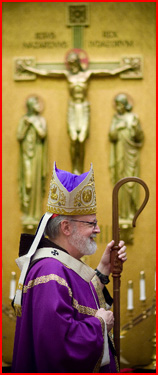
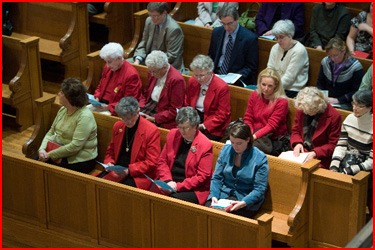
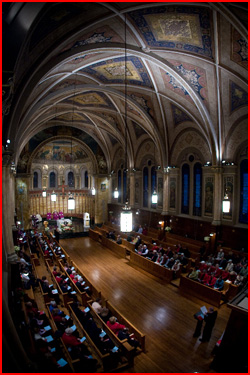
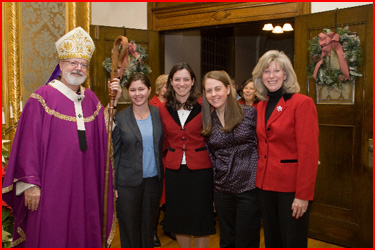
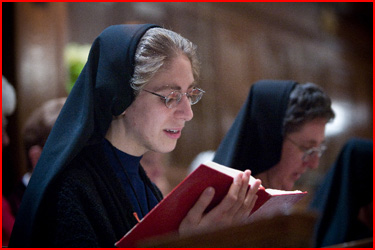
– – –
For the photo of the week, here it is a photo of the groundbreaking ceremony at Sacred Heart that took place in September 2006. Mission accomplished!

Merry Christmas!
Cardinal Seán
